| dc.description.abstract | A detailed study of field-reports, published and unpublished data from archaeological and natural science investigations close to the sea shore in the period from the 1930s to 2005, have been compiled and partly reinterpreted in order to present shore displacement curves. These curves can be used as a tool in location of prehistoric sites in the coastal region of the southwestern part of Norway. This region has experienced a complex shoreline displacement due to pronounced land-sea alteration caused by the interaction of eustacy and isostacy after the deglaciation. The general pattern reveals two distinct transgressions along the coast; one Late Weichselian (Younger Dryas age) and one Holocene transgression (the Tapes transgression, around 6500 yr BP) that intersect close to Reve in Central Jæren. The Tapes level forms the marine limit (ML) southwards in this area. In the northern Boknafjord area an earlier transgression of Bølling age has also been recorded. The shore displacement curves reveal a rapid regression from the Younger Dryas throughout the Preboreal chronozones, putting the brakes on southwards. The regression minimum in the Preboreal chronozone is below the present sea-level south of the Hafrsfjord area. Special attention has been paid to two, possibly three, shortlived marine events. The oldest marine event, dated to ca 9800-9700 yr BP, is only recorded in the Boknafjord area. Sediment studies at the localities Storavatn in Tysvær and the flooded Ahrensburgian site Galta 3 at Rennesøy, point in favour of a local tsunami. Three sites, Hålandsvannet, the Sola airport site and Braastadvann at Lista, show possible indications of the Storegga tsunami dated to 7350-7250 yr BP, but none of these sites record the typical tsunami facies that has been described for the Storegga tsunami layers elsewhere in Norway. The Storegga tsunami in this area is probably lower than the Tapes maximum level giving a possible run-up of 2-3 m. The youngest marine event, dated to ca 4800 yr BP, is recorded from the Karmøy sound and further southwards along the coast to Eigerøy. It levels out eastwards in the Boknafjord area. This event is the result of a small sea-level rise – a transgression – and verifies that the Tapes transgression was double-peaked along this coastal area. The two peaks intersect in the coastal zone at the Randaberg peninsula, the 4800 yr BP event being the highest one southwards. | |
